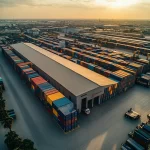Listen to the audio version of the blog here:
In a significant shift in international trade relations, the United States has increased tariffs on Indian imports from an average of 2.6% to a substantial 26%. This policy change, announced on April 2, 2025, aims to address trade imbalances and protect domestic industries. Understanding the reasons behind this decision, its effects on various sectors, and strategies for Indian exporters to navigate these challenges is crucial.
Reasons for the Tariff Increase
The U.S. administration’s decision to raise tariffs on Indian goods stems from several factors:
- Trade Imbalances: The U.S. has expressed concerns over the growing trade deficit with India, particularly in sectors like automobiles and electronics.
- Reciprocal Tariffs: Historically, India has maintained higher tariffs on certain U.S. imports, such as passenger vehicles and apples, with duties reaching up to 70% and 50% respectively. The U.S. views these rates as disproportionately high, prompting the implementation of reciprocal tariffs to encourage trade balance.
Effects and Challenges for Indian Exports
The tariff hike is poised to impact several key sectors:
- Automobiles and Auto Components: With tariffs now at 25%, products like passenger vehicles, especially those priced above $40,000, and auto parts face increased costs, potentially reducing competitiveness in the U.S. market.
- Electronics: While the direct impact may be neutral, the broader context of increased tariffs on Chinese electronics could present both challenges and opportunities for Indian electronics exporters.
- Gems and Jewellery: Facing tariffs up to 25%, this sector is vulnerable, given the U.S. is a significant market for Indian gems and jewelry.
- Aluminum and Steel: The 25% tariff on aluminum imports poses a substantial challenge, as the U.S. is a key market for Indian aluminum exports.
- Pharmaceuticals: Currently exempt from these tariffs, the sector remains unaffected. However, any future policy changes could have significant implications, given India’s role as a major supplier of generic medicines to the U.S.
Strategies for Indian Exporters
To mitigate the adverse effects of increased tariffs, exporters can adopt several strategies:
- Diversification of Markets: Exploring alternative markets beyond the U.S., such as the European Union, Middle East, and ASEAN countries, can reduce dependency and open new revenue streams.
- Value Addition: Focusing on adding value to products can help maintain competitiveness. For instance, in the textile sector, producing high-quality, branded garments may offset tariff impacts.
- Strengthening Trade Relations: Engaging in trade negotiations and seeking favorable terms can help address tariff challenges. India’s ongoing discussions with the U.S. aim to resolve trade disputes and establish more balanced trade agreements.
- Supply Chain Optimization: Improving supply chain efficiency can help reduce costs, making products more price-competitive.
Despite the challenges posed by increased tariffs, India has historically demonstrated resilience in international trade and logistics. The government’s proactive approach in negotiating trade agreements, coupled with the industry’s adaptability, positions India to navigate these changes effectively. By implementing strategic measures and an efficient Supply Chain, Indian exporters can sustain and potentially grow their presence in global markets.



